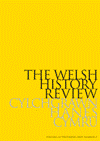
Ritual, Symbol and Politics: Gladstone, Swansea and Wales in 1887
Document Type: Research Article
Publication date: 01 July 2013
Published by the University of Wales Press since its inception in 1960, The Welsh History Review / Cylchgrawn Hanes Cymru is the most authoritative journal in its field. This twice-yearly journal is committed to publishing research on Welsh history, from medieval to modern. The internationally-renowned editorial board includes scholars from universities in Wales, the UK, Europe and the United States, whose collective breadth of knowledge contributes to a diverse range of cultural, social, political and economic history.
Cyhoeddwyd The Welsh History Review / Cylchgrawn Hanes Cymru gan Wasg Prifysgol Cymru ers sefydlu'r cyfnodolyn yn 1960. Hwn yw'r cyfnodolyn mwyaf awdurdodol yn ei faes, a'i brif hanfod yw arddangos amrywiaeth eang o feysydd ymchwil ym maes hanes Cymru, o'r canoloesol hyd at y modern. Ar y bwrdd golygyddol, ceir ysgolheigion o brifysgolion Cymru, y Deyrnas Unedig, Ewrop a'r Unol Daleithiau. Adlewyrchir arbenigeddau'r bwrdd yng nghynnwys y cyfnodolyn, sydd yn ymdrin â hanes diwylliannol, cymdeithasol, gwleidyddol ac economaidd.
- Information for Authors
- Subscribe to this Title
- Ingenta Connect is not responsible for the content or availability of external websites
- Access Key
- Free content
- Partial Free content
- New content
- Open access content
- Partial Open access content
- Subscribed content
- Partial Subscribed content
- Free trial content